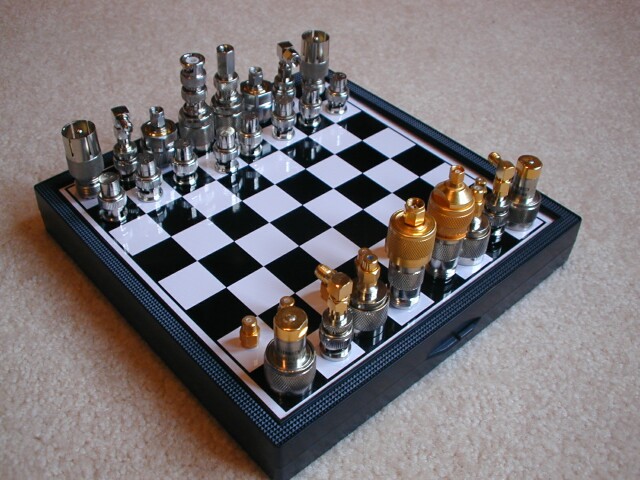Chess is a two-player board game played on a chessboard, a square-checkered board with 64 squares arranged in an eight-by-eight grid. It is one of the world's most popular games, played by millions of people worldwide at home, in clubs, online, by correspondence, and in tournaments.
Each player begins the game with sixteen pieces: one king, one queen, two rooks, two knights, two bishops, and eight pawns, each of these types of pieces moving differently. Pieces are used to attack and capture the opponent's pieces. The object of the game is to checkmate the opponent's king by placing it under threat of capture ("check") which cannot be avoided. In addition to checkmate, the game can be won by the voluntary resignation of one's opponent, which may occur when too much material is lost, or if checkmate appears unavoidable. A game may result in a draw in several ways, and neither player wins. The course of the game is divided in three phases. The beginning of the game is called the opening (with the development of pieces). The opening yields to the phase called the middlegame. The last phase is the endgame, generally characterized by the disappearance of queens.
The first official World Chess Champion, Wilhelm Steinitz, claimed his title in 1886; the current World Champion is Viswanathan Anand. In addition to the World Championship, there are the Women's World Championship, the Junior World Championship, the World Senior Championship, the Correspondence Chess World Championship, the World Computer Chess Championship, and Blitz and Rapid World Championships. The Chess Olympiad is a popular competition among teams from different nations. Online chess has opened amateur and professional competition to a wide and varied group of players. Chess is a recognized sport of the International Olympic Committee, and international chess competition is sanctioned by the FIDE (Fédération Internationale des Échecs or World Chess Federation). There are also many chess variants that have different rules, different pieces, and different boards.
Commencing in the second half of the 20th century, computers have been programmed to play chess with increasing success to the point where home computers can play chess at a very high level. In the past two decades computer analysis has contributed significantly to chess theory as understood by human players, particularly in the endgame. The computer program Deep Blue was the first machine player to overcome a reigning World Chess Champion when it defeated Garry Kasparov in 1997.
Each player begins the game with sixteen pieces: one king, one queen, two rooks, two knights, two bishops, and eight pawns, each of these types of pieces moving differently. Pieces are used to attack and capture the opponent's pieces. The object of the game is to checkmate the opponent's king by placing it under threat of capture ("check") which cannot be avoided. In addition to checkmate, the game can be won by the voluntary resignation of one's opponent, which may occur when too much material is lost, or if checkmate appears unavoidable. A game may result in a draw in several ways, and neither player wins. The course of the game is divided in three phases. The beginning of the game is called the opening (with the development of pieces). The opening yields to the phase called the middlegame. The last phase is the endgame, generally characterized by the disappearance of queens.
The first official World Chess Champion, Wilhelm Steinitz, claimed his title in 1886; the current World Champion is Viswanathan Anand. In addition to the World Championship, there are the Women's World Championship, the Junior World Championship, the World Senior Championship, the Correspondence Chess World Championship, the World Computer Chess Championship, and Blitz and Rapid World Championships. The Chess Olympiad is a popular competition among teams from different nations. Online chess has opened amateur and professional competition to a wide and varied group of players. Chess is a recognized sport of the International Olympic Committee, and international chess competition is sanctioned by the FIDE (Fédération Internationale des Échecs or World Chess Federation). There are also many chess variants that have different rules, different pieces, and different boards.
Commencing in the second half of the 20th century, computers have been programmed to play chess with increasing success to the point where home computers can play chess at a very high level. In the past two decades computer analysis has contributed significantly to chess theory as understood by human players, particularly in the endgame. The computer program Deep Blue was the first machine player to overcome a reigning World Chess Champion when it defeated Garry Kasparov in 1997.





